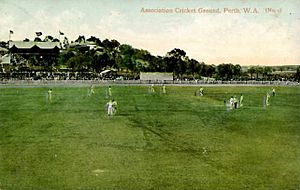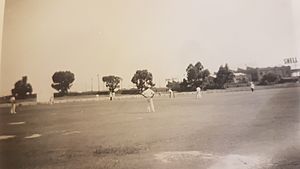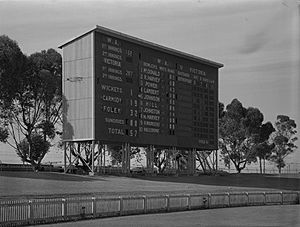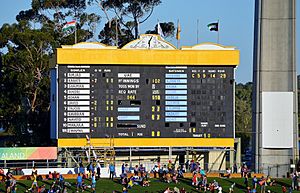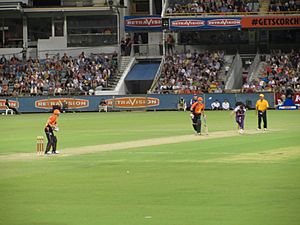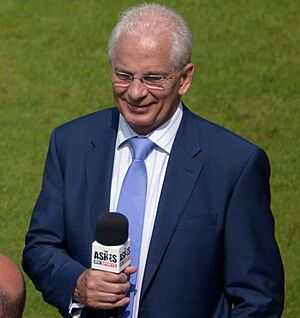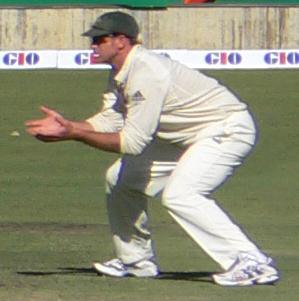WACA Ground facts for kids
 |
|||||||||||||||||

During the 3rd Test of the 2006/07 Ashes
|
|||||||||||||||||
| Location | East Perth, Western Australia | ||||||||||||||||
|---|---|---|---|---|---|---|---|---|---|---|---|---|---|---|---|---|---|
| Coordinates | Lua error in Module:Coordinates at line 614: attempt to index field 'wikibase' (a nil value). | ||||||||||||||||
| Owner | Western Australian Cricket Association | ||||||||||||||||
| Operator | Western Australian Cricket Association | ||||||||||||||||
| Capacity | 20,000 | ||||||||||||||||
| Record attendance | 34,317 – 1994 AFL finals | ||||||||||||||||
| Surface | Grass | ||||||||||||||||
| Opened | 1890 | ||||||||||||||||
| Website | |||||||||||||||||
| https://wacaground.com.au/ | |||||||||||||||||
| Ground information | |||||||||||||||||
| End names | |||||||||||||||||
Gloucester Park End (formerly Prindiville Stand End)  Members' (or Lillee-Marsh Stand) End |
|||||||||||||||||
| International information | |||||||||||||||||
| First Test | 11–16 December 1970: |
||||||||||||||||
| Last Test | 14–18 December 2017: |
||||||||||||||||
| First ODI | 9 December 1980: |
||||||||||||||||
| Last ODI | 19 January 2017: |
||||||||||||||||
| First T20I | 11 December 2007: |
||||||||||||||||
| Last T20I | 31 October 2010: |
||||||||||||||||
| First women's Test | 21–24 March 1958: |
||||||||||||||||
| Last women's Test | 15–17 February 2024: |
||||||||||||||||
| First WODI | 12 March 2005: |
||||||||||||||||
| Last WODI | 22 February 2019: |
||||||||||||||||
| First WT20I | 22 February 2020: |
||||||||||||||||
| Last WT20I | 24 February 2020: |
||||||||||||||||
| Team information | |||||||||||||||||
|
|||||||||||||||||
| As of 17 February 2024 Source: ESPN Cricinfo |
|||||||||||||||||
The WACA Ground is a famous sports stadium in Perth, Western Australia. Its name, WACA, comes from the initials of its owners, the Western Australian Cricket Association.
Since the 1890s, the WACA has been known as Western Australia's "home of cricket". Important Test cricket matches have been played there since 1970. It is the home ground for Western Australia's top cricket teams. These include the Western Warriors and the Western Fury women's team. The Perth Scorchers, a Big Bash League team, also played there until 2019. Now, many big matches, including those for the Australian national team, are held at the larger Perth Stadium nearby.
The pitch at the WACA is known for being one of the fastest and bounciest in the world. This, along with the afternoon sea-breezes (called the Fremantle Doctor), makes it a great place for fast bowlers. The outfield is also very quick. This means players can score runs very fast. The WACA has seen some of the quickest centuries in Test cricket history.
Over the years, the WACA has hosted many other sports. These include athletics, Australian rules football, baseball, soccer, rugby league, and rugby union. It has also been a venue for big rock concerts. There is a WACA Museum on site, showing the history of cricket in Western Australia.
Contents
Early Days of the WACA Ground
The first grass cricket pitch at the WACA was laid by William Henry Wise. He was a gardener who came to Western Australia in 1880.
The Western Australian Cricket Association started on November 25, 1885. The WACA ground officially opened in 1893. It was built on what used to be swamp land. The association has a very long lease for the land, lasting 999 years. This means they can use the land almost like they own it.
The first match on the new grass pitches was in February 1894. For many years, it was hard for teams to travel to Western Australia. This meant the WACA was not a main part of Australia's cricket scene. It became easier to reach once regular flights started.
James Gardiner was president of the WACA several times. He helped create 'electorate' cricket, where teams were based on different districts. He also started Country Week cricket for teams from outside the city. In 1907, he helped save the WACA ground from being taken over due to debts.
From 1928 to 1935, motorcycle speedway races were held around the oval. Sadly, a champion rider named Sig Schlam died in a crash there in 1930.
Changes and Upgrades to the Ground
The WACA Ground has been changed and updated many times over the years. Here are some of the most important changes:
- In 1895, the first grandstand was built. It could seat 500 people and had changing rooms and dining areas.
- The Farley Stand opened in 1931, named after a former WACA president and secretary.
- A storm destroyed the scoreboard in 1948. A new, now famous, scoreboard was built in 1954. It is still used today.
- In the 1960s, the Players Pavilion was built for players and WACA staff. More seats were added for the first Test match in 1970.
- The "Test Stand" also opened in 1970. It was later renamed the Inverarity Stand.
- From 1984 to 1988, the WACA had big renovations. The playing field was changed and new seating was added.
Other new buildings included:
- The Prindiville Stand, built in 1985.
- The Lillee-Marsh Stand, built in 1988, named after famous cricketers Dennis Lillee and Rod Marsh. This stand increased the number of seats.
Six tall light towers were also put up in 1986. These lights cost $4.2 million and allowed night games to be played. The lights are 70 meters high and cost $600 per hour to run.
These changes made the WACA a popular place for other sports too. In the late 1980s and early 1990s, it was used a lot for different sports. From 1987 to 2000, the West Coast Eagles and Fremantle Dockers (AFL teams) played there. The WA Reds rugby league team also used it from 1995 to 1997.
Later, most of these sports moved to other venues. In 2002, the WACA was changed again. Its seating capacity was reduced to about 20,000. Some stands were taken down and replaced with grass hills. The playing area was also made smaller. This meant Australian rules football could no longer be played there. Sometimes, temporary stands are used to increase the capacity to 24,500.
In 2013, a new video screen was put up near the old scoreboard.
Future Plans and Upgrades
By the 2018-2019 summer, the WACA Ground was no longer the main place for international cricket in Perth. The new Perth Stadium took over most big matches. The WACA planned to become a smaller, special stadium with better facilities.
In March 2019, the WACA shared plans to improve cricket training areas. They also wanted to host big community events. The plans included changing the ground so it could host Australian rules football matches again. The total cost was estimated at $75 million.
In August 2019, the government gave $100,000 to build two new changing rooms for women's cricket. These were ready for the 2020 ICC Women's T20 World Cup. In December 2019, the WACA received $30 million from the Federal Government for major upgrades. The Western Australian Government also gave the same amount.
Redevelopment work started in August 2021. The Inverarity and Prindiville stands were taken down. They are being replaced by a community sports center and a new public building. The grass hills are also being changed so Australian rules football can be played again. New facilities will include a cricket training center, a new museum, a cafe, a gym, and a 50-meter outdoor swimming pool. There will also be an indoor learn-to-swim pool and waterslides. Five of the light towers were upgraded with new LED lights. These lights can change colors, like those at Perth Stadium. They were first turned on in December 2022.
A contract for the work was given in November 2023. The project is expected to be finished in 2025.
The East Fremantle Football Club played their home matches at the WACA during the 2022, 2023, and 2024 WAFL seasons. This was while their own ground was being redeveloped.
Memorable Moments at the WACA
- 1899
- The first important cricket match was played here between Western Australia and South Australia in April 1899.
- 1930s
- In 1932, famous cricketer Donald Bradman played at the WACA for the first time. Over 20,000 people came to watch.
- The world's first international women's cricket match was played at the WACA in November 1934. It was between Western Australia and a touring England team.
- 1950s
- In March 1958, the first women's Test match in Perth was held at the WACA. It ended in a draw.
- 1960s
- In October 1967, Western Australia's Ian Brayshaw took 10 wickets for only 44 runs against Victoria. This was one of the best bowling performances in Sheffield Shield history.
- 1970s
- In the first men's Test match at the WACA in December 1970, Australia's Greg Chappell scored 108 runs in his first Test match.
- The Rolling Stones performed at the WACA in February 1973.
- Doug Walters scored a century (100 runs) in just one session against England in 1974.
- In December 1975, West Indian Roy Fredericks scored a century in only 71 balls. This was one of the fastest centuries in Test history at the time.
- In 1977, Australian batsman Tony Mann scored 108 runs as a nightwatchman against India. This is very rare in Test cricket.
- In March 1979, there was a famous incident where Pakistan's Sikander Bakht was Mankaded (run out by the bowler before he bowled). Later, Australian Andrew Hilditch was out for handled the ball after touching the ball. These dismissals caused a lot of discussion about fair play.
- In December 1979, Dennis Lillee tried to bat with an aluminium bat instead of a wooden one. Play stopped for ten minutes until he changed it.
- 1980s
- The first one-day international match at the WACA was played on December 9, 1980, between India and New Zealand.
- In 1981, Dennis Lillee and Pakistani batsman Javed Miandad had a clash on the pitch. Lillee kicked Miandad, and Miandad raised his bat. Lillee was fined and suspended.
- In 1982, Terry Alderman was injured while tackling a fan who ran onto the field.
- The record crowd for a one-day cricket match at the WACA was 27,057 in February 1984.
- In 1986, Western Australia played Victoria in the first cricket match under lights at the ground.
- Merv Hughes took a hat-trick against the West Indies in 1988. He took 13 wickets in the match, which is a record for the ground.
- New Zealander Mark Greatbatch scored 146 not out in November 1989. He batted for almost 11 hours to save his team from losing.
- Geoff Marsh scored 355 not out for Western Australia in December 1989. This is the highest score by a Western Australian at the ground.
- 1990s
- Steve Waugh and Mark Waugh made a record partnership of 464 runs for New South Wales in 1990.
- In January 1993, Curtly Ambrose had an amazing bowling spell, taking 7 wickets for only 1 run.
- The largest cricket crowd at the WACA, 28,210, watched Australia play South Africa in January 1994.
- The biggest crowd ever at the WACA was 34,317. This was for an AFL football match in September 1994.
- In 1995, the Western Reds Rugby League team played their first game at the WACA.
- The first international soccer friendly was played at the WACA in June 1995.
- 2000s
- In December 2000, Australia's Glenn McGrath took a Test hat-trick. He also got his 300th Test wicket.
- In February 2001, Damien Martyn scored 144 not out in a one-day international, the highest individual score at the ground.
- Australia's Matthew Hayden scored a record 380 runs against Zimbabwe in 2003. This was the highest Test score in the world at the time.
- In 2004, Glenn McGrath took 8 wickets for 24 runs against Pakistan. These are his best Test bowling figures and the best ever at the WACA.
- KISS started their "Rock the Nation Tour" at the WACA in May 2004.
- In January 2005, the WACA hosted its first Twenty20 match. It had a sellout crowd of 20,700.
- Adam Gilchrist hit the second fastest century in Test history (now fourth fastest) in December 2006. He scored 100 runs off just 57 balls.
- The WACA hosted its first Twenty20 International match in December 2007.
- India defeated Australia in January 2008, ending Australia's record of 16 straight Test wins.
- South Africa won a Test match in December 2008 by chasing down 414 runs. This was the second-highest successful run chase in Test history.
- In December 2009, West Indian Chris Gayle scored one of the fastest centuries in Test cricket history.
- 2010s
- In January 2010, Pakistan captain Shahid Afridi was suspended for ball tampering during a match.
- In January 2012, Australian batsman David Warner scored a century off 69 balls. This was one of the fastest in Test cricket history.
- The Guinness World Record for the highest basketball shot was set from one of the WACA's floodlight towers.
- In January 2014, the WACA hosted its third women's Test match between England and Australia. England won a very close game.
- In November 2015, David Warner scored 253 runs against New Zealand. Later, Ross Taylor scored 290 runs, the highest score against an Australian team in Australia.
- On December 14, 2017, the WACA hosted its final Ashes Test. In this match, many players scored centuries, including Dawid Malan, Mitchell Marsh, Jonny Bairstow, and Steve Smith. Smith and Marsh also made the highest partnership for the 5th wicket at the WACA. Australia won the match and regained the Ashes.
- On January 25, 2018, the WACA hosted its final Big Bash League match.
- 2020s
- Between March 6-9, 2026, the WACA Ground will host its first Day Night Test Match for women. It will be between Australia and India.
Test Cricket Records
Top Batting Records
| Runs | Player | Period |
|---|---|---|
| 965 (26 innings) | 1995–2012 | |
| 931 (26 innings) | 1979–1993 | |
| 846 (19 innings) | 1985–1995 | |
| 843 (21 innings) | 1986–2003 | |
| 825 (10 innings) | 2012–2017 |
| Runs | Player | Period |
|---|---|---|
| 471 (10 innings) | 1978–1991 | |
| 422 (6 innings) | 2005–2012 | |
| 326 (2 innings) | 2015–2015 | |
| 320 (6 innings) | 2005–2012 | |
| 319 (6 innings) | 1970–1979 |
| Runs | Player | Date |
|---|---|---|
| 380 v. Zimbabwe | 9 Oct 2003 | |
| 290 v. Australia | 13 Nov 2015 | |
| 253 v. New Zealand | 13 Nov 2015 | |
| 239 v. England | 14 Dec 2017 | |
| 231 v. Sri Lanka | 8 Dec 1995 |
| Centuries | Player | Period |
|---|---|---|
| 3 (9 innings) | 2010–2024 | |
| 3 (10 innings) | 2012–2017 | |
| 2 (6 innings) | 2005–2012 | |
| 2 (7 innings) | 1986–1992 | |
| 2 (9 innings) | 1993–2000 | |
| 2 (10 innings) | 1978–1991 | |
| 2 (13 innings) | 1970–1983 | |
| 2 (14 innings) | 1999–2008 | |
| 2 (15 innings) | 2005–2012 | |
| 2 (16 innings) | 1991–2001 | |
| 2 (16 innings) | 1993–2006 | |
| 2 (19 innings) | 1985–1995 | |
| 2 (26 innings) | 1979–1993 |
| Average | Player | Period |
|---|---|---|
| 84.40 (6 innings, 1 NO) | 2005–2012 | |
| 82.50 (10 innings, 0 NO) | 2012–2017 | |
| 81.33 (7 innings, 1 NO) | 1986–1992 | |
| 70.75 (6 innings, 2 NO) | 1970–1975 | |
| 69.50 (6 innings, 2 NO) | 1985–1993 |
Top Bowling Records
| Wickets | Player | Period |
|---|---|---|
| 52 (24 innings) | 1993–2006 | |
| 45 (14 innings) | 2008–2015 | |
| 40 (16 innings) | 2000–2008 | |
| 39 (11 innings) | 1988–1993 | |
| 38 (15 innings) | 1985–1995 |
| Wickets | Player | Period |
|---|---|---|
| 24 (6 innings) | 1988–1997 | |
| 18 (4 innings) | 1980–1985 | |
| 14 (8 innings) | 1978–1986 | |
| 14 (8 innings) | 1974–1982 | |
| 13 (4 innings) | 1993–1997 |
| Figures | Player | Date |
|---|---|---|
| 8/24 v. Pakistan | 1 Dec 2004 | |
| 8/61 v. South Africa | 17 Dec 2008 | |
| 8/87 v. West Indies | 2 Dec 1988 | |
| 8/97 v. England | 1 Feb 1991 | |
| 7/25 v. Australia | 30 Jan 1993 | |
| 7/27 v. India | 1 Feb 1992 | |
| 7/54 v. Australia | 12 Dec 1975 |
| Figures | Player | Date |
|---|---|---|
| 13/217 v. West Indies | 2 Dec 1988 | |
| 11/95 v. India | 1 Feb 1992 | |
| 11/118 v. Pakistan | 11 Nov 1983 | |
| 11/155 v. Australia | 30 Nov 1985 | |
| 11/157 v. England | 1 Feb 1991 | |
| 11/159 v. South Africa | 17 Dec 2008 | |
| 11/176 v. Australia | 14 Dec 1979 |
Team Records
| Score | Team | Date |
|---|---|---|
| 6/735d | 9 Oct 2003 | |
| 6/662d | 14 Dec 2017 | |
| 624 | 13 Nov 2015 | |
| 5/617d | 8 Dec 1995 | |
| 8/592d | 28 Nov 1986 |
| Score | Team | Date |
|---|---|---|
| 62 | 13 Nov 1981 | |
| 72 | 16 Dec 2004 | |
| 76 | 9 Nov 1984 | |
| 104 | 22 Nov 2024 | |
| 112 | 28 Nov 1998 |
Partnership Records
| Runs | Wicket | Players | Match | Date |
|---|---|---|---|---|
| 327 | 5th | Ricky Ponting (197) & Justin Langer (144) | 26 Nov 1999 | |
| 302 | 2nd | David Warner (253) & Usman Khawaja (121) | 13 Nov 2015 | |
| 301 | 5th | Steve Smith (239) & Mitchell Marsh (181) | 14 Dec 2017 | |
| 265 | 3rd | Ross Taylor (290) & Kane Williamson (166) | 13 Nov 2015 | |
| 259 | 2nd | Wayne Phillips (159) & Graham Yallop (141) | 11 Nov 1983 |
| Runs | Wicket | Players | Match | Date |
|---|---|---|---|---|
| 228 | 1st | Michael Slater (219) & Mark Taylor (96) | 8 Dec 1995 | |
| 302 | 2nd | David Warner (253) & Usman Khawaja (121) | 13 Nov 2015 | |
| 265 | 3rd | Ross Taylor (290) & Kane Williamson (166) | 13 Nov 2015 | |
| 207 | 4th | Matthew Hayden (380) & Steve Waugh (78) | 9 Oct 2003 | |
| 327 | 5th | Ricky Ponting (197) & Justin Langer (144) | 26 Nov 1999 | |
| 233 | 6th | Matthew Hayden (380) & Adam Gilchrist (113*) | 9 Oct 2003 | |
| 149 | 7th | Jeff Dujon (139) & Larry Gomes (127) | 9 Nov 1984 | |
| 253 | 8th | Nathan Astle (156*) & Adam Parore (110) | 30 Nov 2001 | |
| 81 | 9th | Sachin Tendulkar (114) & Kiran More (43) | 1 Feb 1992 | |
| 87 | 10th | Mitchell Starc (68*) & Nathan Lyon (31) | 30 Nov 2012 |
Last updated 4 July 2022.
WACA Cricket Museum
The WACA has a cricket museum right next to the ground. Here, visitors can see cool items from Australian cricket history. The museum shows not only cricket history but also other sports played at the WACA.


